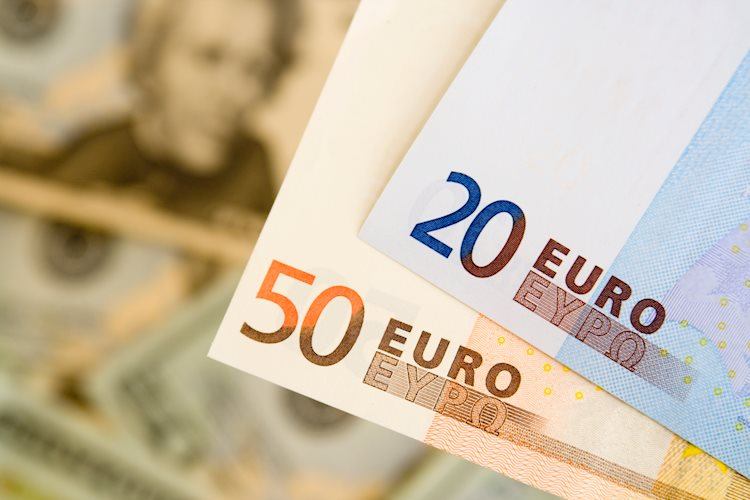- The Euro meets support near 1.0840 against the US Dollar.
- European stocks trade with decent gains across the board.
- US Producer Prices, Retail Sales take centre stage.
The Euro (EUR) loses some upside momentum against the US Dollar (USD), motivating EUR/USD to give away part of the recent strong gains and revisit the 1.0840 zone on Wednesday, where some initial contention seems to have turned up.
On the flip side, the Greenback appears mildly bid in the low 104.00s as investors continue to digest Tuesday’s below-consensus US inflation figures and the subsequent steep sell-off in the USD Index (DXY).
The lacklustre advance in the Greenback comes amidst the marginal bullish attempt in US yields across the curve, as cautiousness remains high in light of the upcoming release of further inflation measures, this time from Producer Prices, as well as Retail Sales for the month of October.
A glimpse of Tuesday’s session suggests that the publication of weaker-than-expected US CPI reignited speculation of potential interest rate cuts by the Fed, most likely around the summer of 2024.
In the domestic calendar, the European Commission’s (EC) Autumn Forecasts now see the economy of the Eurozone expanding 0.6% this year (from 0.8%) and 1.2% in 2024, while inflation is projected at 5.6% in 2023 and 3.2% in the next year. Still in the region, the Balance of Trade showed a €10B surplus in September, while Industrial Production contracted 6.9% from a year earlier.
Daily digest market movers: Euro faces some mild downside pressure
- The EUR falters just ahead of 1.0900 against the USD.
- US and German yields dropped markedly post-US CPI.
- Investors anticipate that the Fed could cut rates in June-July 2024.
- The ECB is expected to extend its pause well into next year.
- FX intervention concerns remain well in place around USD/JPY.
- The European Commission publishes its Autumn Forecasts in the region.
- US Producer Prices, Retail Sales are next on tap.
- UK inflation figures surprised to the downside in October.
- China’s Retail Sales, Industrial Production came in above expectations.
Technical Analysis: Euro remains propped up by 55-day SMA
EUR/USD comes under some corrective decline following a move to new highs near 1.0880 on Wednesday.
Next on the upside for EUR/USD emerges the weekly high of 1.0945 (August 30) ahead of the psychological threshold of 1.1000. The surpass of this region could open the door to a visit to the August top of 1.1064 (August 10) and another weekly peak of 1.1149 (July 27), all preceding the 2023 high of 1.1275 (July 18).
Occasional bouts of weakness could prompt the pair to challenge transitory support at the 55-day SMA at 1.0639, prior to the weekly low of 1.0495 (October 13) and the 2023 low of 1.0448. (October 15).
Looking at the broader picture, while above the 200-day SMA at 1.0802, the pair’s outlook should remain constructive.
(This story was corrected on November 15 at 11:23 GMT to say that EUR/USD reached new highs near 1.0880, not lows).
German economy FAQs
The German economy has a significant impact on the Euro due to its status as the largest economy within the Eurozone. Germany’s economic performance, its GDP, employment, and inflation, can greatly influence the overall stability and confidence in the Euro. As Germany’s economy strengthens, it can bolster the Euro’s value, while the opposite is true if it weakens. Overall, the German economy plays a crucial role in shaping the Euro’s strength and perception in global markets.
Germany is the largest economy in the Eurozone and therefore an influential actor in the region. During the Eurozone sovereign debt crisis in 2009-12, Germany was pivotal in setting up various stability funds to bail out debtor countries. It took a leadership role in the implementation of the ‘Fiscal Compact’ following the crisis – a set of more stringent rules to manage member states’ finances and punish ‘debt sinners’. Germany spearheaded a culture of ‘Financial Stability’ and the German economic model has been widely used as a blueprint for economic growth by fellow Eurozone members.
Bunds are bonds issued by the German government. Like all bonds they pay holders a regular interest payment, or coupon, followed by the full value of the loan, or principal, at maturity. Because Germany has the largest economy in the Eurozone, Bunds are used as a benchmark for other European government bonds. Long-term Bunds are viewed as a solid, risk-free investment as they are backed by the full faith and credit of the German nation. For this reason they are treated as a safe-haven by investors – gaining in value in times of crisis, whilst falling during periods of prosperity.
German Bund Yields measure the annual return an investor can expect from holding German government bonds, or Bunds. Like other bonds, Bunds pay holders interest at regular intervals, called the ‘coupon’, followed by the full value of the bond at maturity. Whilst the coupon is fixed, the Yield varies as it takes into account changes in the bond’s price, and it is therefore considered a more accurate reflection of return. A decline in the bund’s price raises the coupon as a percentage of the loan, resulting in a higher Yield and vice versa for a rise. This explains why Bund Yields move inversely to prices.
The Bundesbank is the central bank of Germany. It plays a key role in implementing monetary policy within Germany, and central banks in the region more broadly. Its goal is price stability, or keeping inflation low and predictable. It is responsible for ensuring the smooth operation of payment systems in Germany and participates in the oversight of financial institutions. The Bundesbank has a reputation for being conservative, prioritizing the fight against inflation over economic growth. It has been influential in the setup and policy of the European Central Bank (ECB).
Read the full article here

